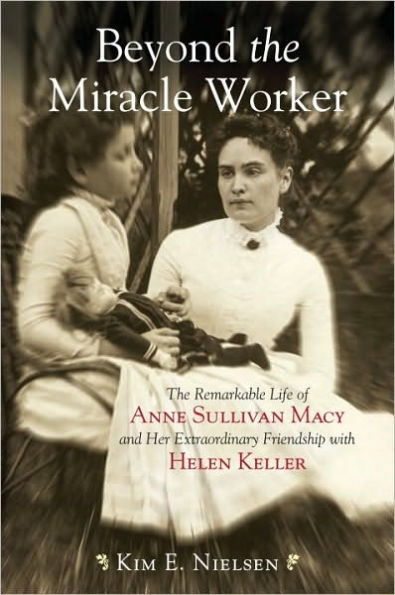After many years, historian and Helen Keller expert Kim Nielsen realized that she, along with other historians and biographers, had failed Anne Sullivan Macy. While Macy is remembered primarily as Helen Keller's teacher and mythologized as a straightforward educational superhero, the real story of this brilliant, complex, and misunderstood woman, who described herself as a "badly constructed human being," has never been completely told.
Beyond the Miracle Worker, the first biography of Macy in nearly fifty years, complicates the typical Helen-Annie "feel good" narrative in surprising ways. By telling the life from Macy's perspective-not Keller's-the biography is the first to put Macy squarely at the center of the story. It presents a new and fascinating tale about a wounded but determined woman and her quest for a successful, meaningful life.
Born in 1866 to poverty-stricken Irish immigrants, the parentless and deserted Macy suffered part of her childhood in the Massachusetts State Almshouse at Tewksbury. Seeking escape, in love with literature, and profoundly stubborn, she successfully fought to gain an education at the Perkins School for the Blind.
As an adult, Macy taught Keller, helping the girl realize her immense potential, and Macy's intimate friendship with Keller remained powerful throughout their lives. Yet as Macy floundered with her own blindness, ill health, and depression, as well as a tumultuous and triangulated marriage, she came to lean on her former student, emotionally, physically, and economically.
Based on privately held primary source material, including materials at both the American Foundation for the Blind and the Perkins School for the Blind, Beyond the Miracle Worker is revelatory and absorbing, unraveling one of the best known-and least understood-friendships of the twentieth century.
After many years, historian and Helen Keller expert Kim Nielsen realized that she, along with other historians and biographers, had failed Anne Sullivan Macy. While Macy is remembered primarily as Helen Keller's teacher and mythologized as a straightforward educational superhero, the real story of this brilliant, complex, and misunderstood woman, who described herself as a "badly constructed human being," has never been completely told.
Beyond the Miracle Worker, the first biography of Macy in nearly fifty years, complicates the typical Helen-Annie "feel good" narrative in surprising ways. By telling the life from Macy's perspective-not Keller's-the biography is the first to put Macy squarely at the center of the story. It presents a new and fascinating tale about a wounded but determined woman and her quest for a successful, meaningful life.
Born in 1866 to poverty-stricken Irish immigrants, the parentless and deserted Macy suffered part of her childhood in the Massachusetts State Almshouse at Tewksbury. Seeking escape, in love with literature, and profoundly stubborn, she successfully fought to gain an education at the Perkins School for the Blind.
As an adult, Macy taught Keller, helping the girl realize her immense potential, and Macy's intimate friendship with Keller remained powerful throughout their lives. Yet as Macy floundered with her own blindness, ill health, and depression, as well as a tumultuous and triangulated marriage, she came to lean on her former student, emotionally, physically, and economically.
Based on privately held primary source material, including materials at both the American Foundation for the Blind and the Perkins School for the Blind, Beyond the Miracle Worker is revelatory and absorbing, unraveling one of the best known-and least understood-friendships of the twentieth century.

Beyond the Miracle Worker: The Remarkable Life of Anne Sullivan Macy and Her Extraordinary Friendship with Helen Keller
320
Beyond the Miracle Worker: The Remarkable Life of Anne Sullivan Macy and Her Extraordinary Friendship with Helen Keller
320Related collections and offers

Product Details
| ISBN-13: | 9780807050507 |
|---|---|
| Publisher: | Beacon Press |
| Publication date: | 03/01/2010 |
| Pages: | 320 |
| Sales rank: | 166,629 |
| Product dimensions: | 6.00(w) x 8.90(h) x 1.00(d) |
About the Author
Customer Reviews
Explore More Items
Relive the sensuality, the romance, and the drama of Fifty Shades Freed—the love story that enthralled millions of readers around the world—through the thoughts, reflections, and dreams of
E L James revisits the world of Fifty Shades with a deeper and darker take on the love story that has enthralled millions of readers around the globe.
Their scorching, sensual affair ended in
Read the ground-breaking science fiction and fantasy classic that
From the beloved author of A Wrinkle in Time comes the definitive edition of her inspirational and timeless poetry, featuring more than 200 original poems, a new Foreword by Sarah Arthur,
NEWBERY MEDAL WINNER - TIME MAGAZINE'S 100 BEST FANTASY BOOKS OF ALL TIME - NOW A MAJOR MOTION PICTURE FROM DISNEY
Read the ground-breaking science fiction and fantasy classic that has delightedThe
One of The Atlantic's Great American Novels
"If one had to identify the single most influential shaping force in modern Black literary history, one would probably have to point to Wright and the
Three extraordinary and impassioned nonfiction works by Richard Wright, one of America's premier literary giants of the twentieth century, together in one volume, with an introduction by Cornel
Ésta es la historia de Gregory Reeves, un
“Un libro que capta mi entera atención al exponer la relación de la autora con ese país suyo, inventado, imaginario, ficcional, con la historia de su familia, que a su vez
